Product Link: https://www.fasttech.com/products/0/10047085/9624010-rockbros-bp05-18650-li-ion-battery-pack-power
FastTech contacted me to choose a product to review. Since I had recently reviewed the 4-cell ROCKBROS battery pack I requested the 2-cell version and they agreed to send it to me free of charge. As always, I give my honest opinions and state the facts from my tests.
First of all, just like with the 4-cell pack, this pack is actually a “2,600mAh” battery pack. The manufacturer has again wrongly added up the capacity for both cells. (When cells are in series the voltage increases, but capacity does not change; when cells are in parallel the voltage remains the same, but capacity increases.) This pack is a typical 8.4v pack with 2 cells in series (2s or 2S1P).
FastTech shipped this pack out standard shipping on March 10th, 2018 and it took its good old time getting to me being delivered to me on April 25th, 2018. I’m unsure if the fact that the package had lithium ion cells in it caused the delay or not. The battery pack arrived with the same velcro strap as the 4-cell pack, however the 2-cell does not come with the charger. This is something to keep in mind when ordering this pack. To my knowledge the charger is not available for purchase separately. It arrived in a stock white box inserted into a bubble pack envelope. I feel the packaging was sufficient (though at a minimum amount of protection). On a postal scale it weighed in at 4.4oz.
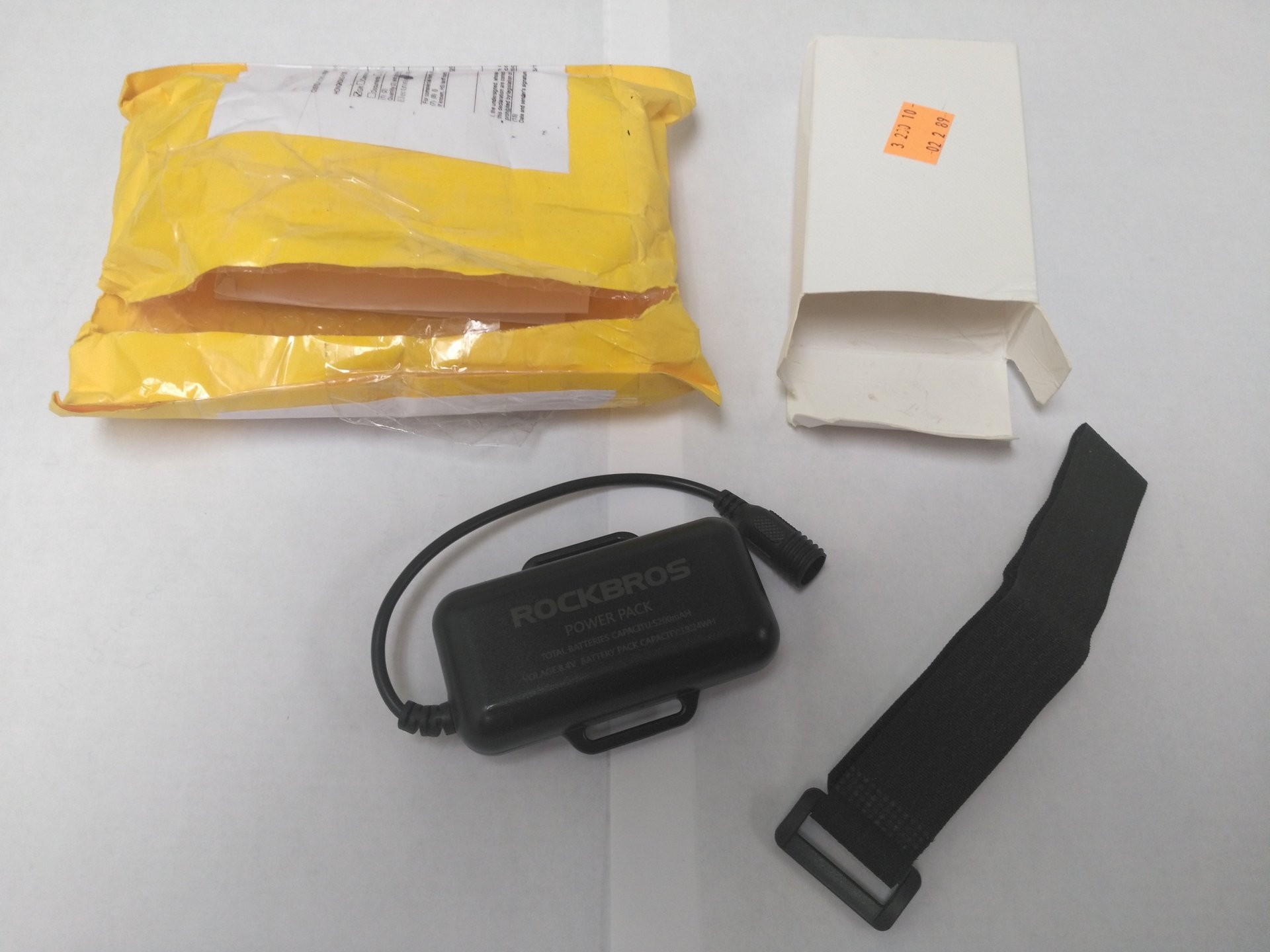
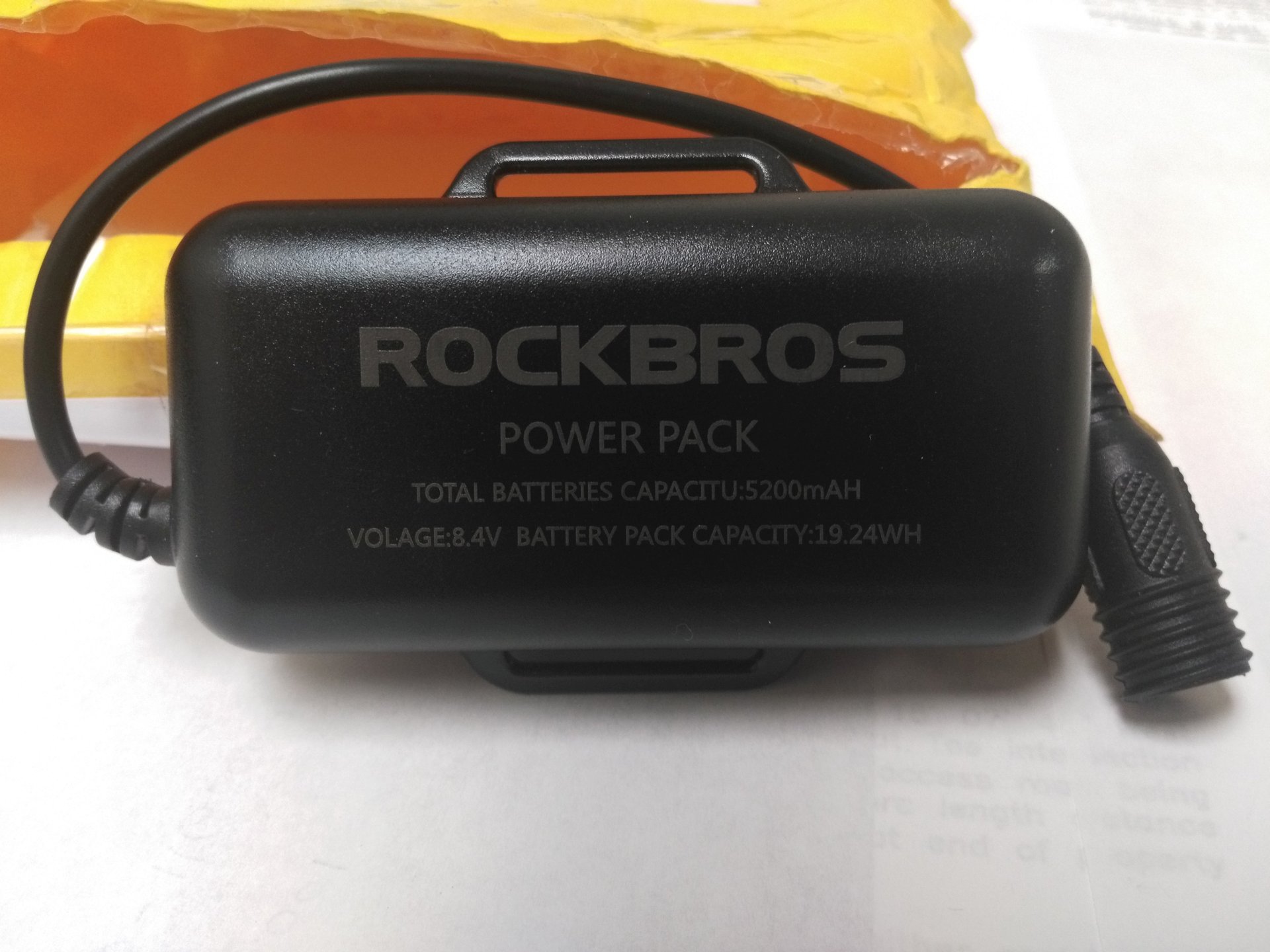
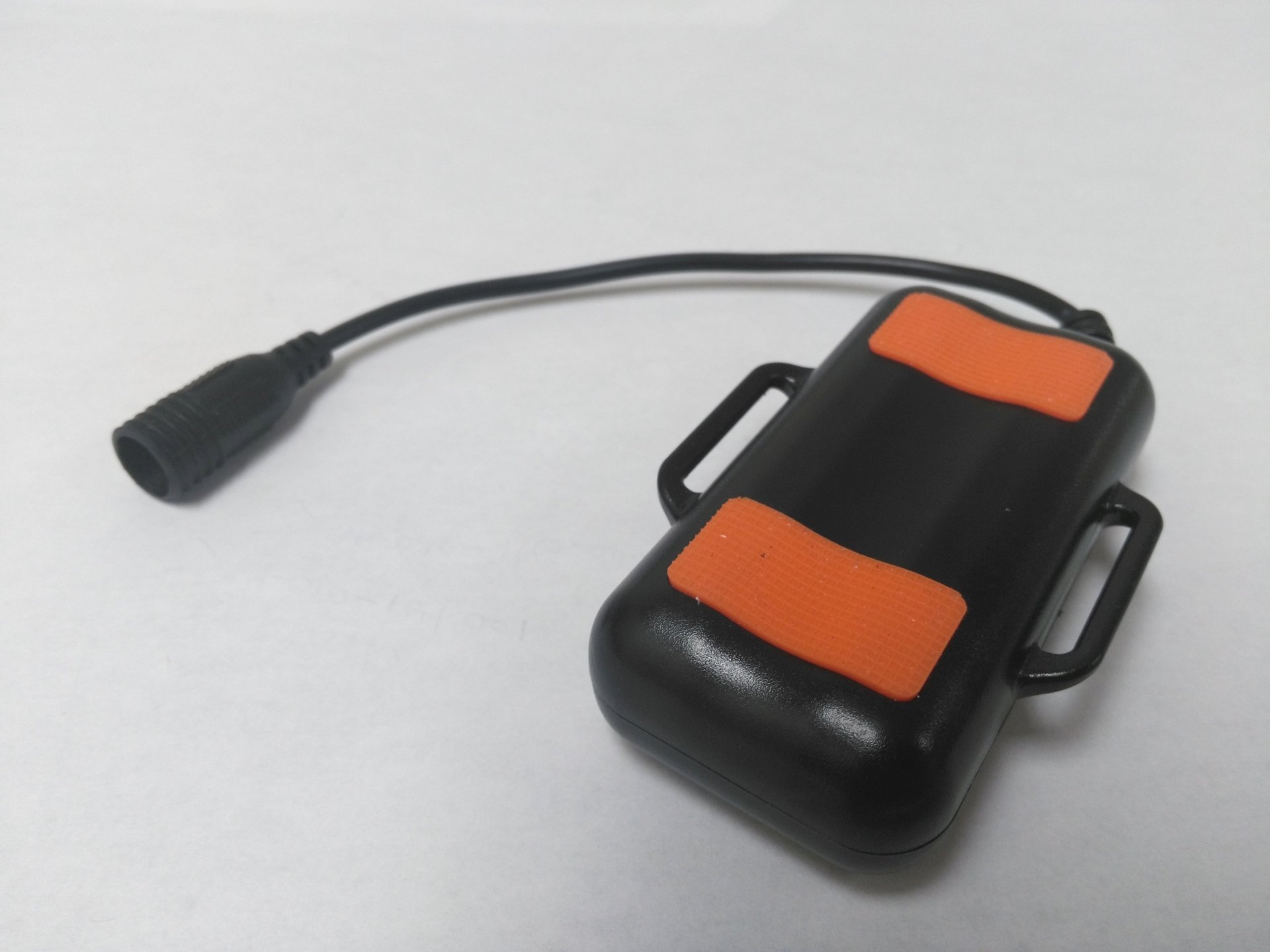
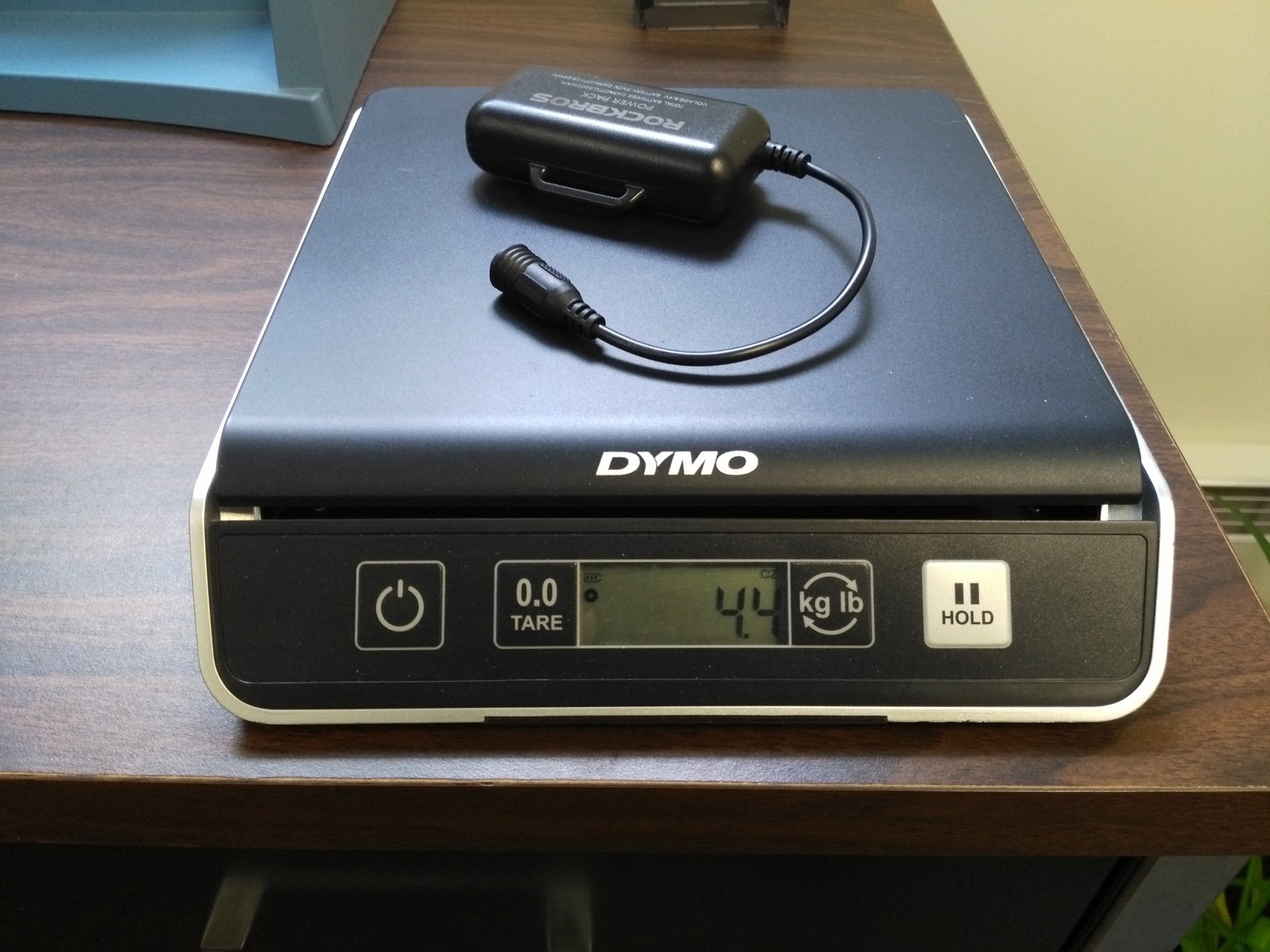
As you can see (just like with the 4-cell pack), there are some spelling errors on the battery pack itself. As with the 4-cell pack, it has an appearance/feel of being decent quality. The rubber pads on the back of the battery case work well for their intended “anti-slip” purpose. The velcro strap is wide and works well. The pack arrived measuring 7.45v (3.725v per cell). After the initial charge (I used the charger from the 4-cell pack) the pack measured 8.33v rather than 8.40v as one would expect. This led me to suspect unbalanced cells inside the pack. I continued testing in this “as-received” condition and investigated this issue afterward.
Next began discharge cycles on my rebranded iCharger 206bB (as received, no cell balancing or any modding). Each test was started from a fully charged pack as it comes off the wall charger (thereby simulating exactly what a user would experience). I started with a 1.0A discharge down to 6.0v. The test ran 2 hours 30 minutes, yielded 2,518mAh, and what appears to be a respectable voltage curve. This was the first discharge cycle of the pack.
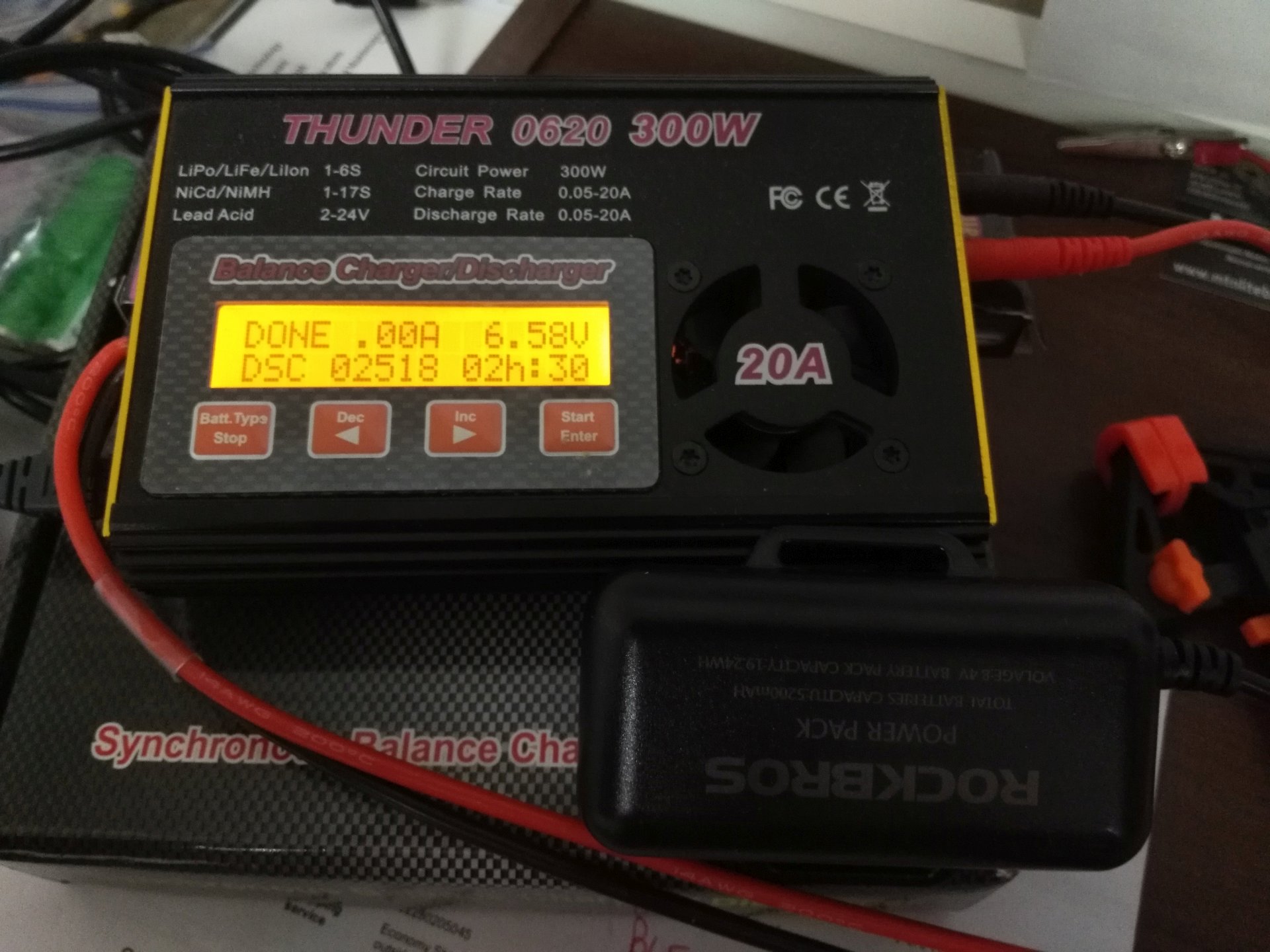
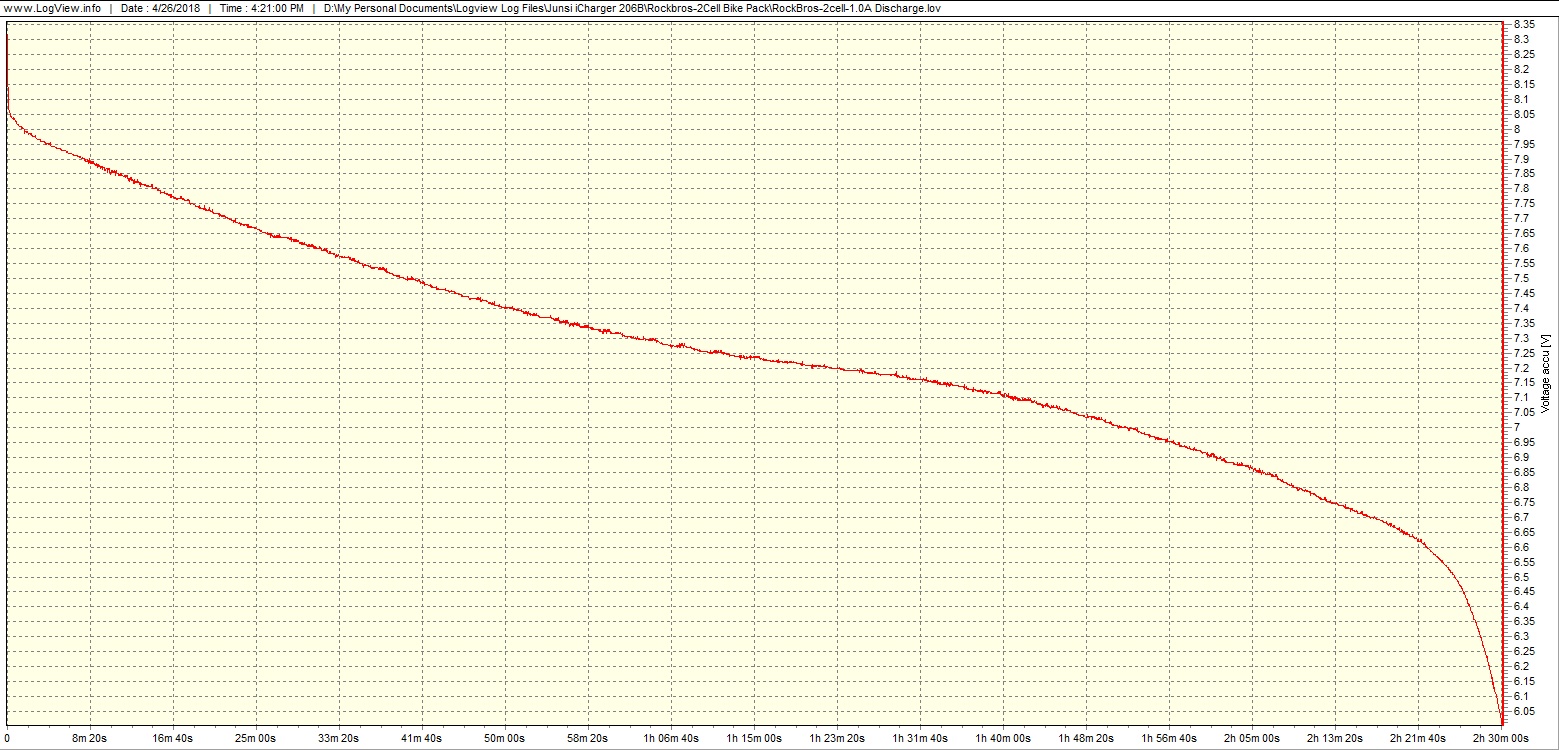
I recharged with the wall charger and the charger’s indicator light went green when the pack measured 8.25v (leaving the charger on is essential to reach a true full charge state.
Next, I ran a 2.0A discharge test (2nd cycle on the pack). This test ran 1 hour 15 minutes and yielded 2,511mAh. With a typical cheap Chinese pack I would have expected the capacity on the 2A test to drop drastically from the 1A test, but in this case it did not further indicating that I’m not testing low quality cells.
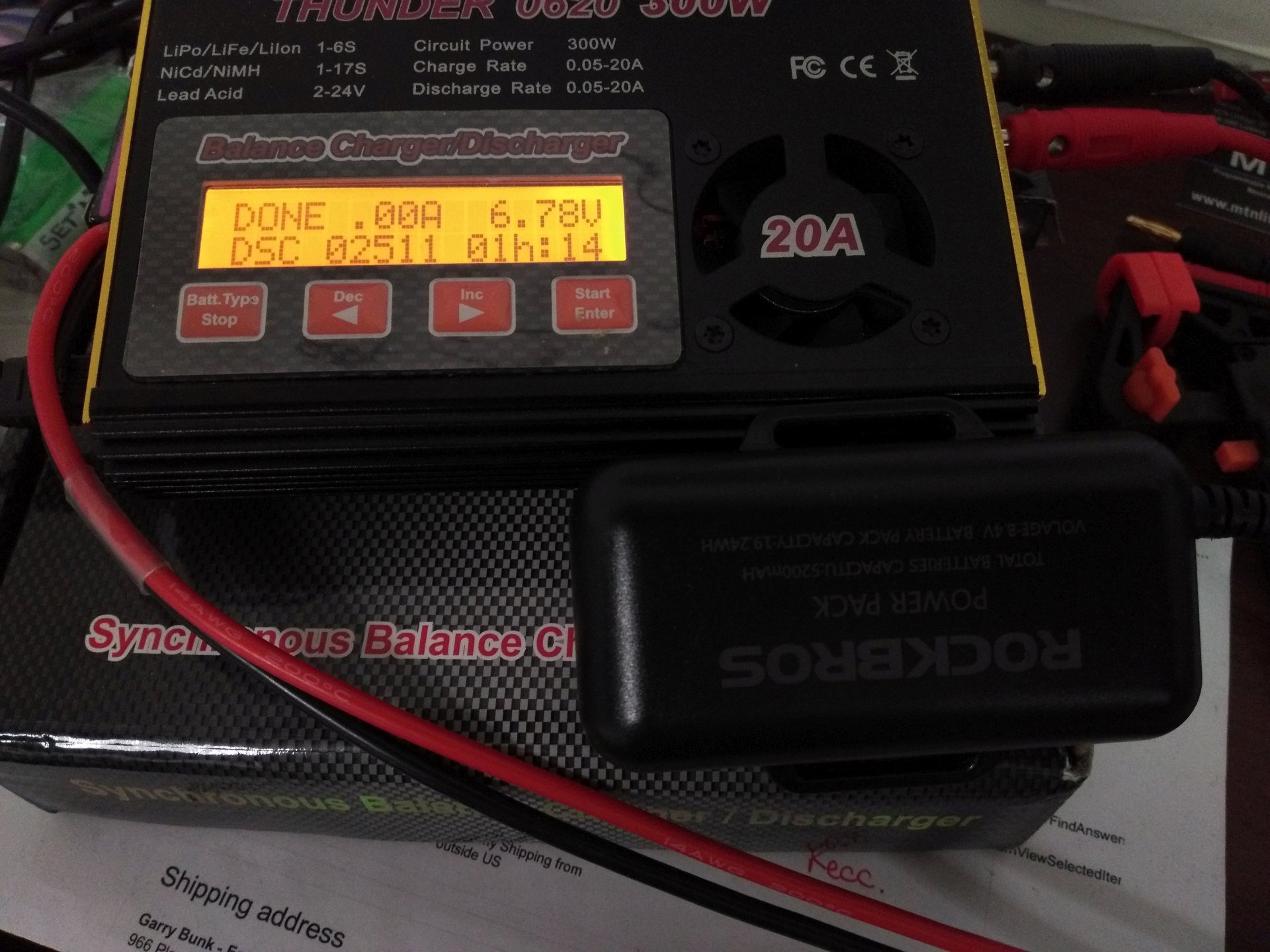
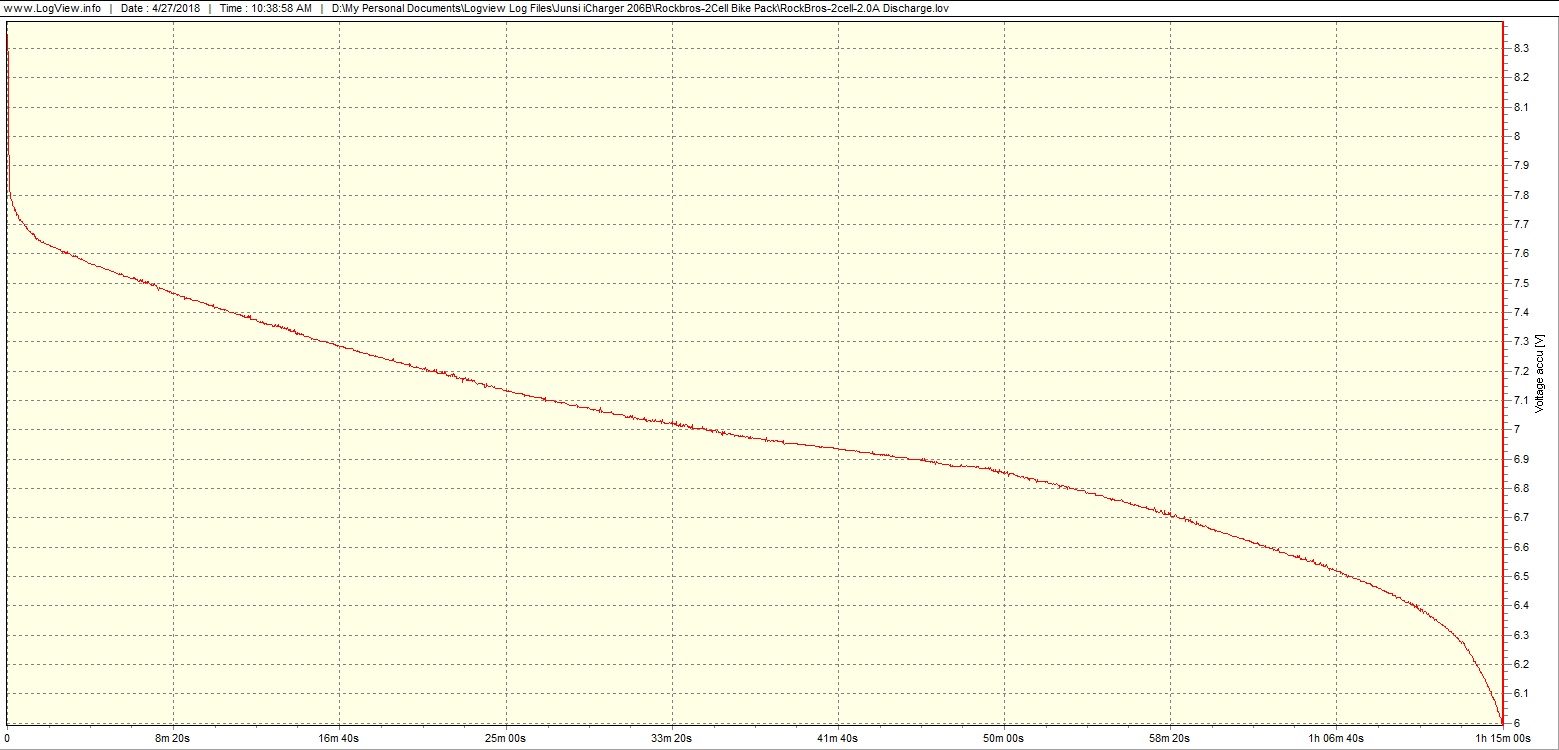
Next, I ran what I will call a 20 watt discharge (the limit of my hobby charger without discharging through an external load). This test started 2.5A current draw and increased over the course of 50 minutes to a max of 3.0A. (I actually set the hobby charger to 3.0A, so technically it drops below 20 watt at some point during discharge.) This test ran 50 minutes 38 seconds yielding 2,474mAh, still very respectable.
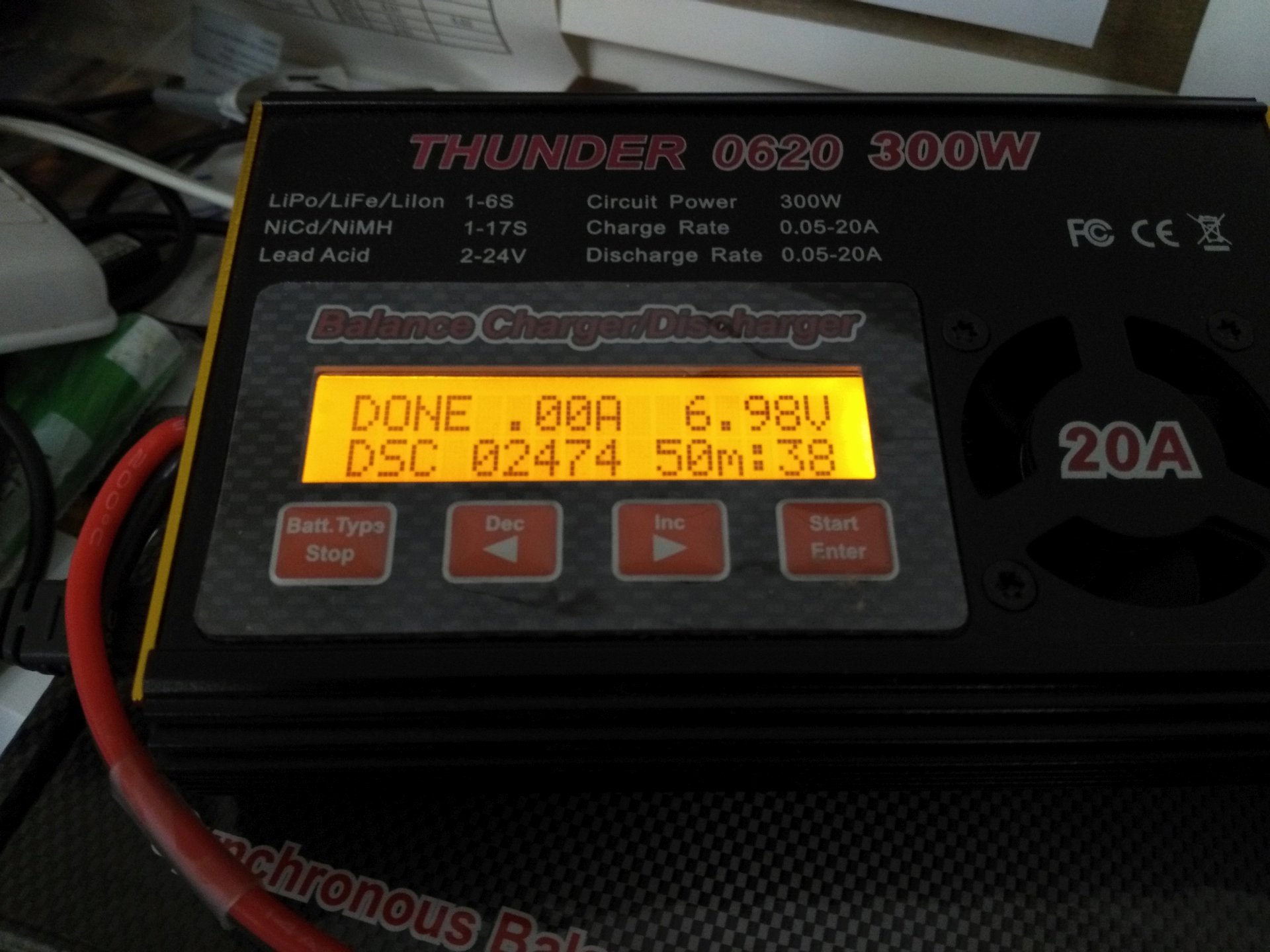
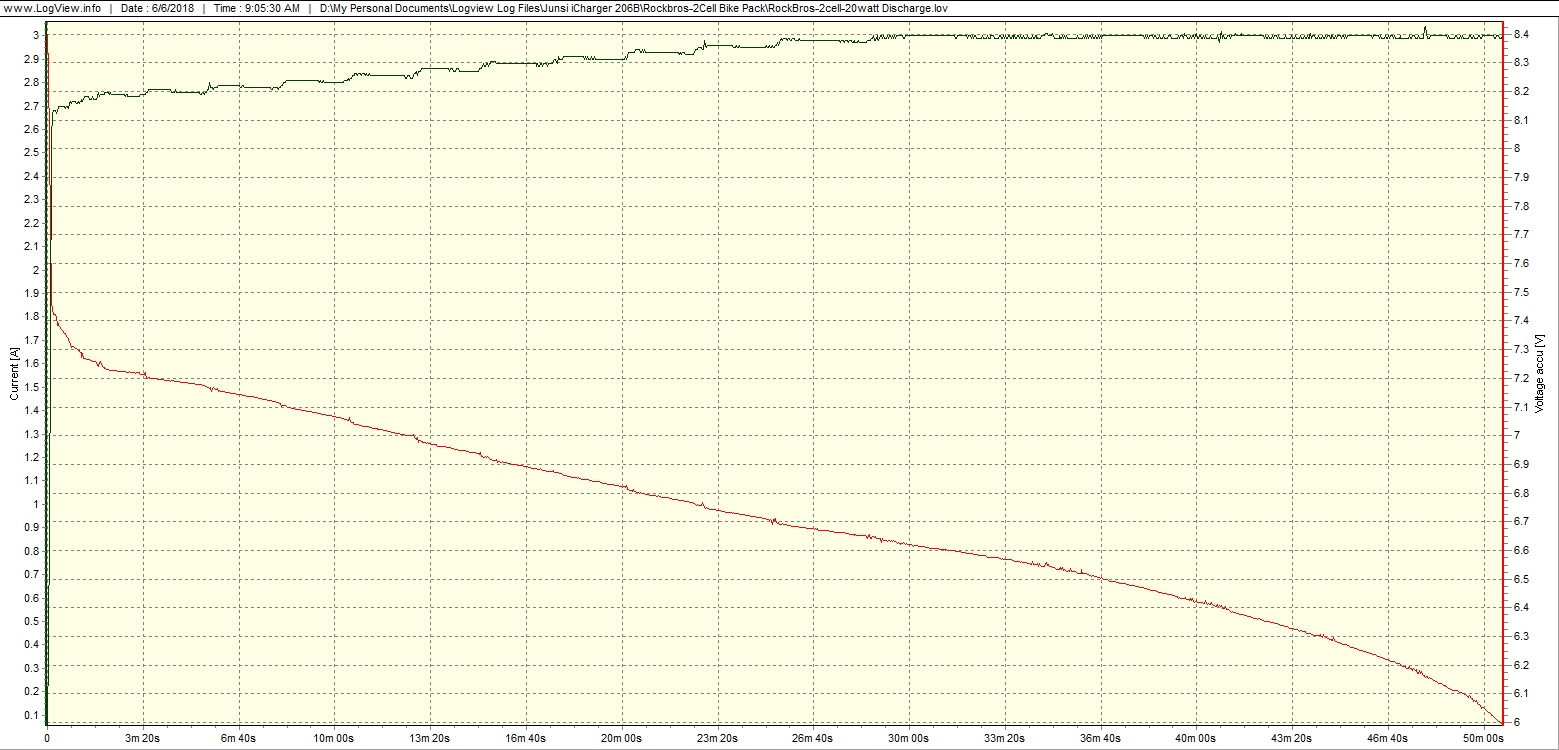
As I did with the 4-cell pack, I connected my highly modded Revtronic (aka. Nitefighter) BT40S to the pack and monitored current pulled from the pack on Turbo. This light is modded to draw a calculated 4.0A and I have few battery packs/cases that can provide the full 4 amps. On this RockBros pack this light pulled 3.59A at start, was at 3.50A at the 30 second mark, and still at 3.39A at 60 seconds – not bad at all! This shows it’s not a junk pack with recycled cells. Here is that 60 second test:
YOUTUBE: 60 SECOND RUNTIME TEST VIDEO
Next, I disassembled the pack and checked out the internals. As with the 4-cell pack, this pack was quite difficult to get apart. You have to be very careful while poking tools into the seams and prying that you don’t cause a short and let out the “magic smoke”!
Inside I found two nice new looking 18650’s with a small protection circuit. The welds on the cells all looked very good and solid and so did solder joints. Wires between the cell pair contacts and the protection pcb were only 24AWG, but this seems to be acceptable. One thing disappointing (and a bit scary) was seeing the insulation ripped open exposing the wire on one of the power leads (see photo below). Measuring voltage of the cell pairs showed they were only slightly out of balance: one cell at 4.15v and the other at 4.17v.
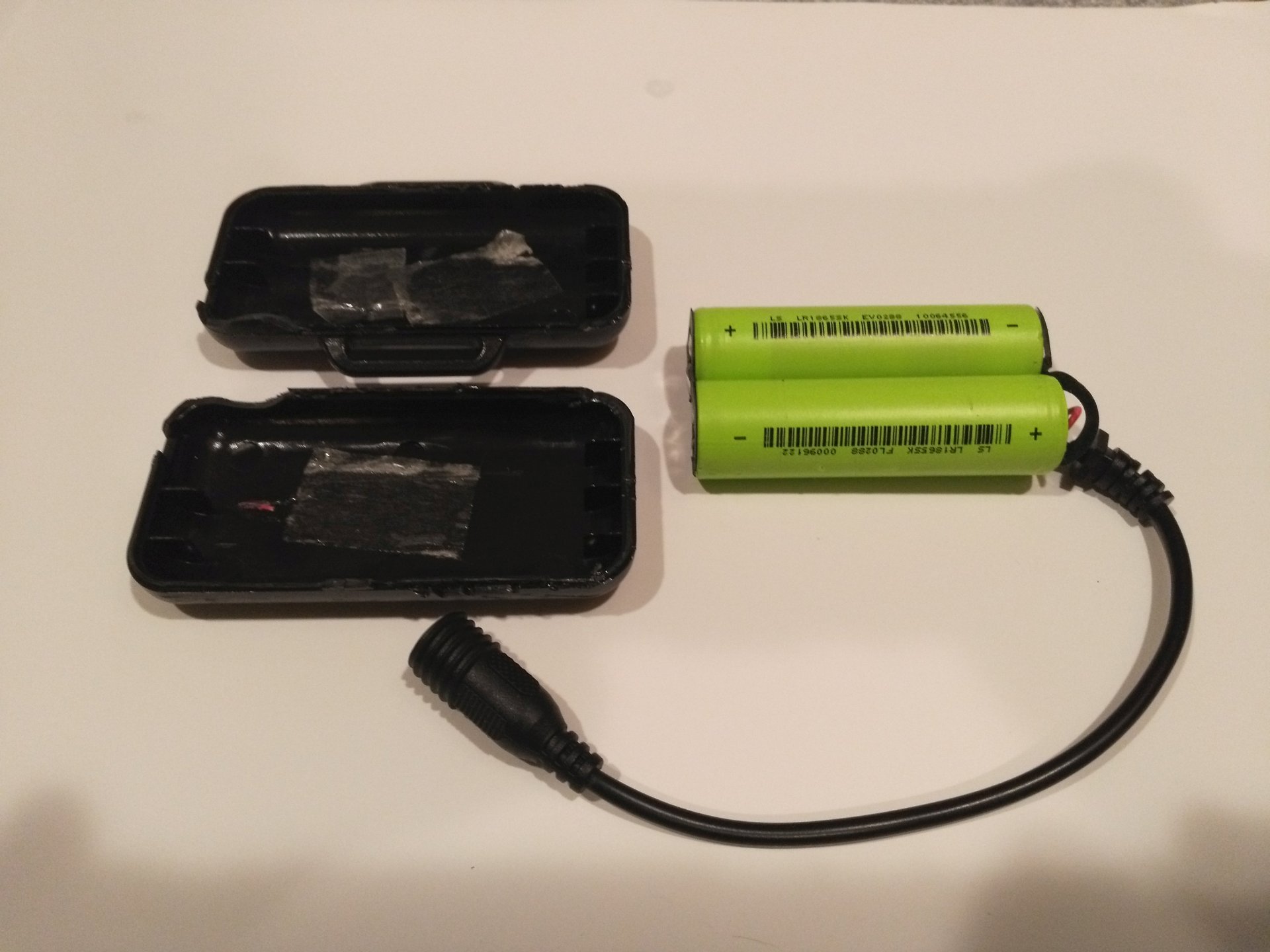
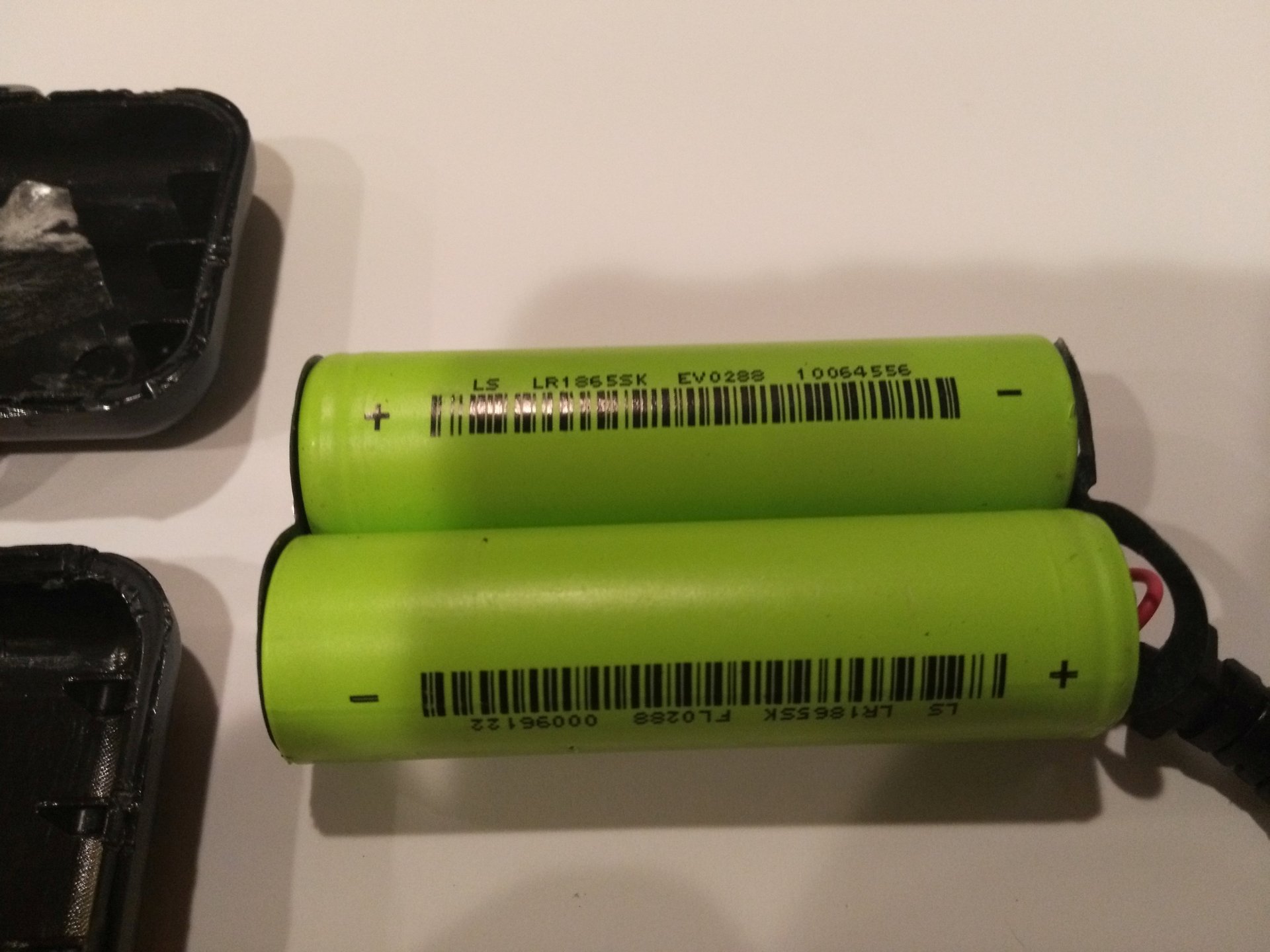
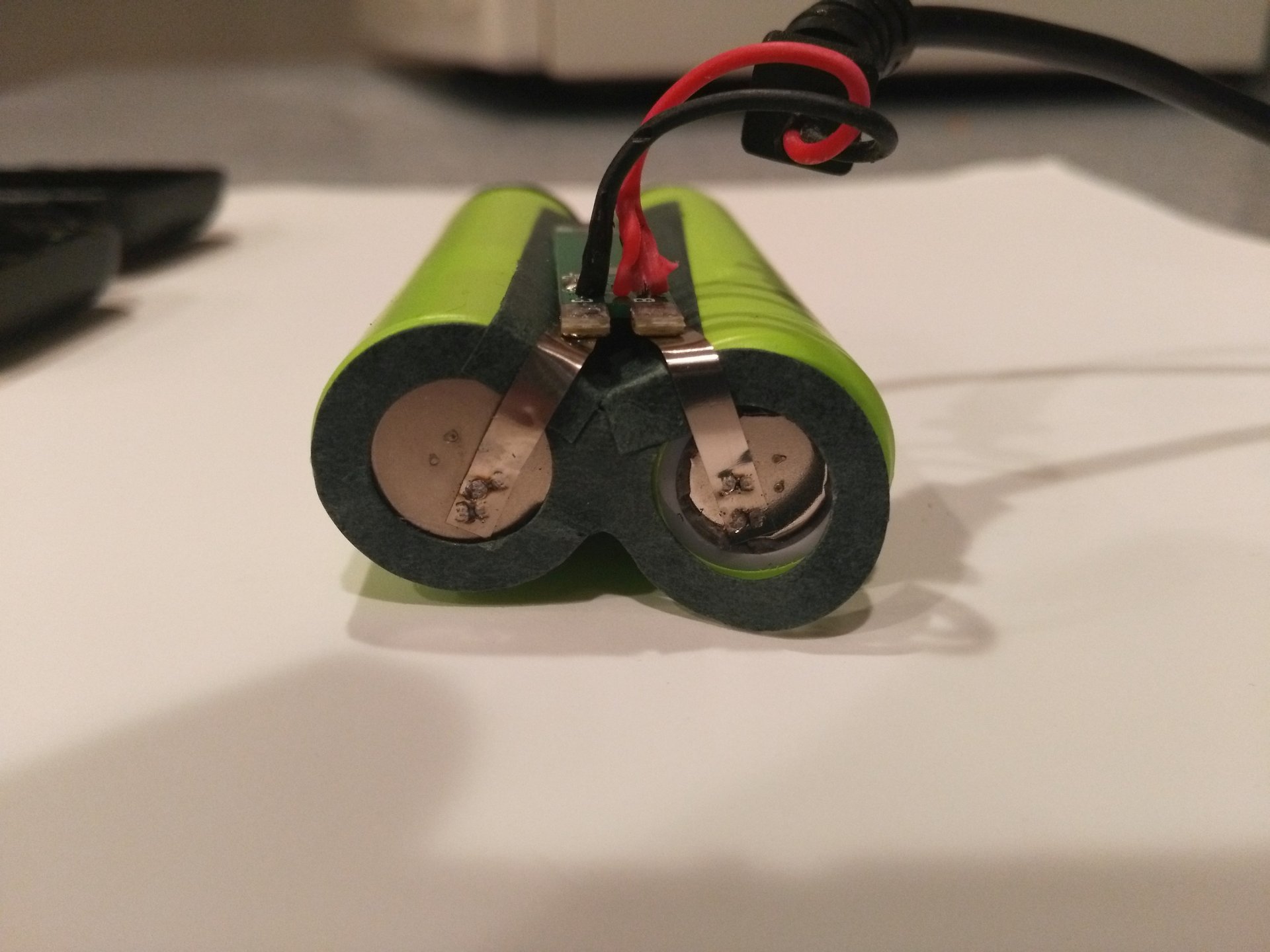
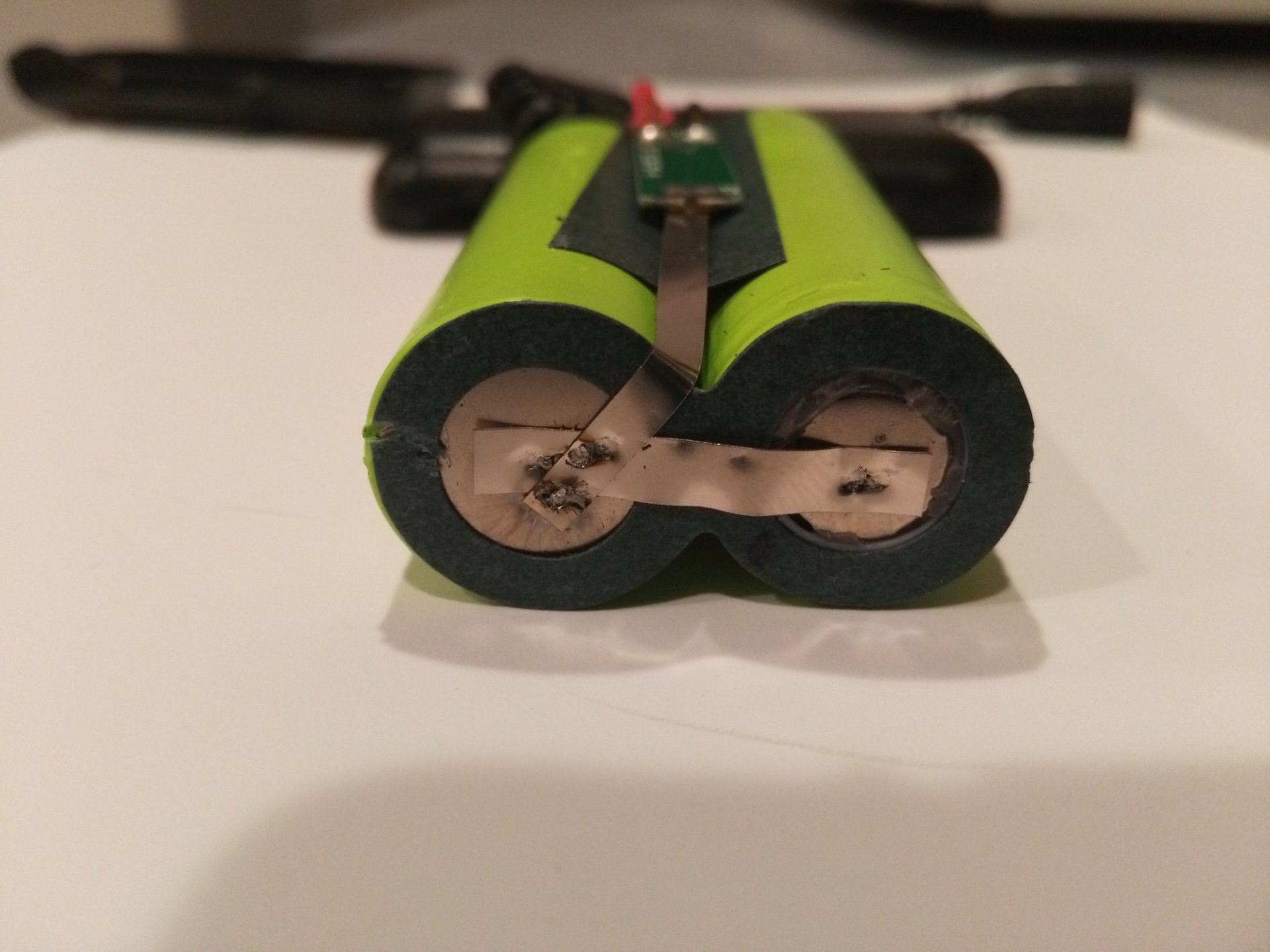
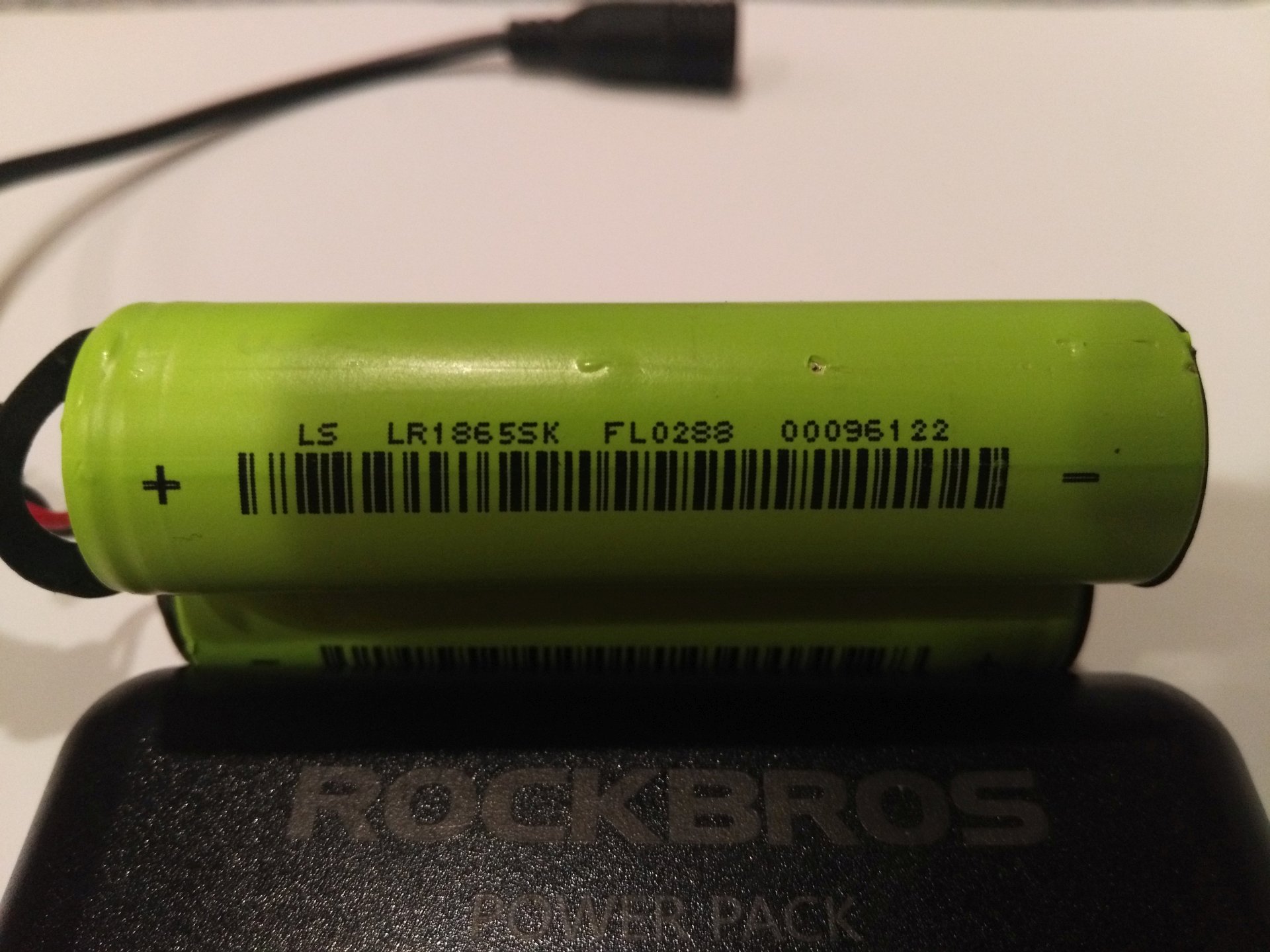
The cells are different from the ones in my previously reviewed 4-cell pack. These are labeled “LS LR1865SK” with no mAh rating label. A Google search seems to indicate these are manufactured by “Lishen (Tianjin Lishen Battery)” and further searching indicates this company has supplied li-ion cells to Apple and Xiaomi. The cell’s data sheet lists these as being 2,600mAh, max charge current of 1,300mA, max discharge current at 2C (5.2A), end voltage of 2.75v, and a cycle life of at least 300 cycles. I have no experience with this brand of cells, but they appear to be at least a decent quality cell. The datasheet can be found here: https://secondlifestorage.com/showthread.php?tid=2587see link below in that thread too.
The protection circuit is the same one used in the 4-cell pack, stamped “CF-2S3675-A”. (The below information is copied over from the 4-cell pack review.) I found a Russian webpage that shows specs linked here through Google Translate: https://translate.google.com/translate?hl=en&sl=ru&u=https://tagelkit.ru/goods/Kontroller-zaryada-razryada-2-h-Li-Ion-18650-7-4V-3A-CF-2S3675-A&prev=search Apparently, there is a 3A and 5A version of this circuit. Please note that this webpage is showing specs on the 3A version. I’m assuming this pack uses the 5A version since I was able to pull over 4A from it. I think I am correct in this assumption because that Russian webpage only shows 1 MOSFET on the 3A pcb and the pcb in this pack has 2 MOSFETS. The MOSFETS by the way are the ubiquitous 8205A variety.
According to the listed specs, this pcb provides short-circuit protection, over-discharge protection set at 2.9v, and over-charge protection at 4.28v. This 3A version lists over-current protection at 4.5A. Note that I did not test the over-charge protection level as I don’t have a charger that over-charges cells and the included charger should never reach that voltage level.

(Note the ripped insulation/exposed wires on the power leads in the photo above.)
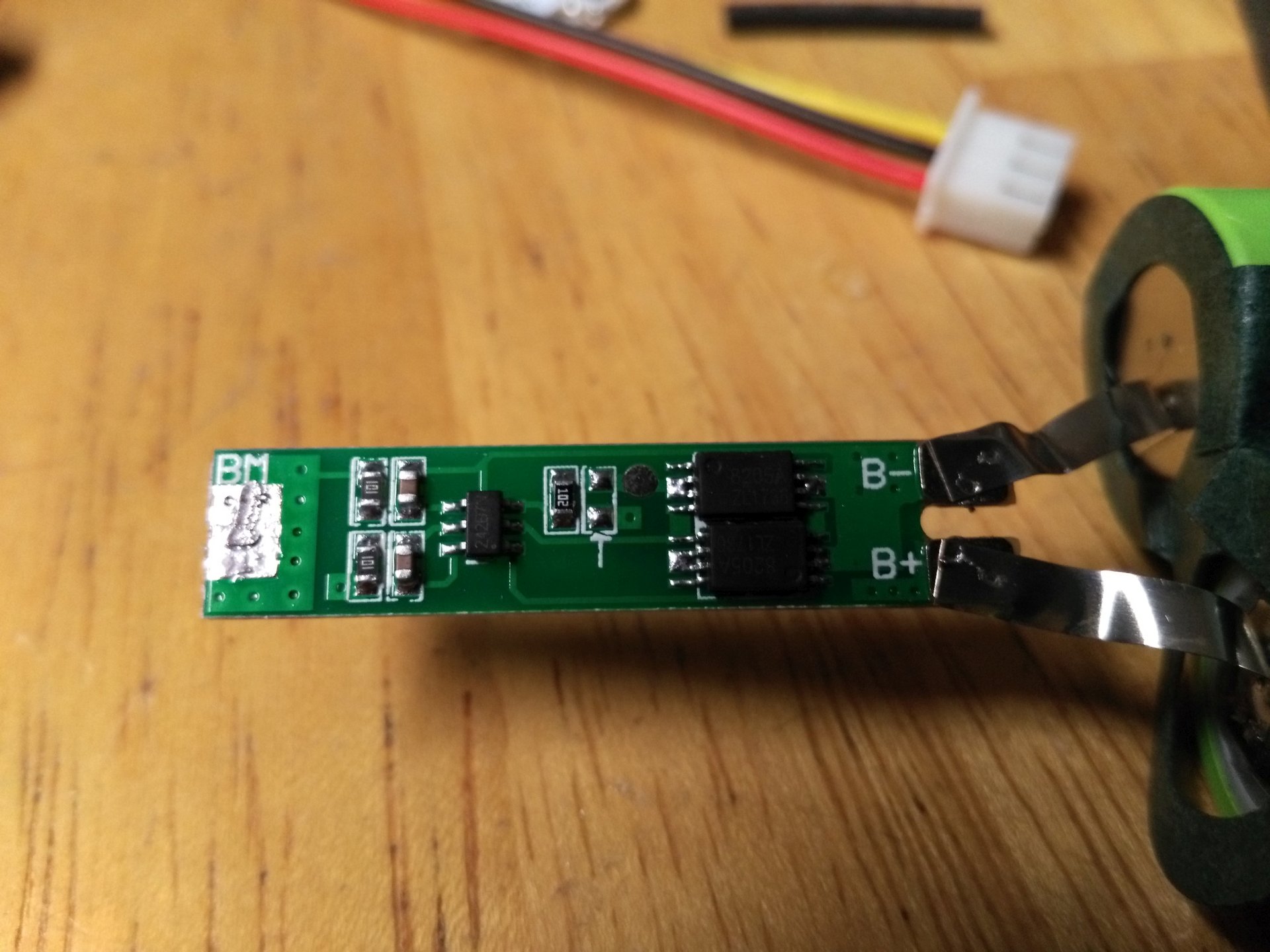
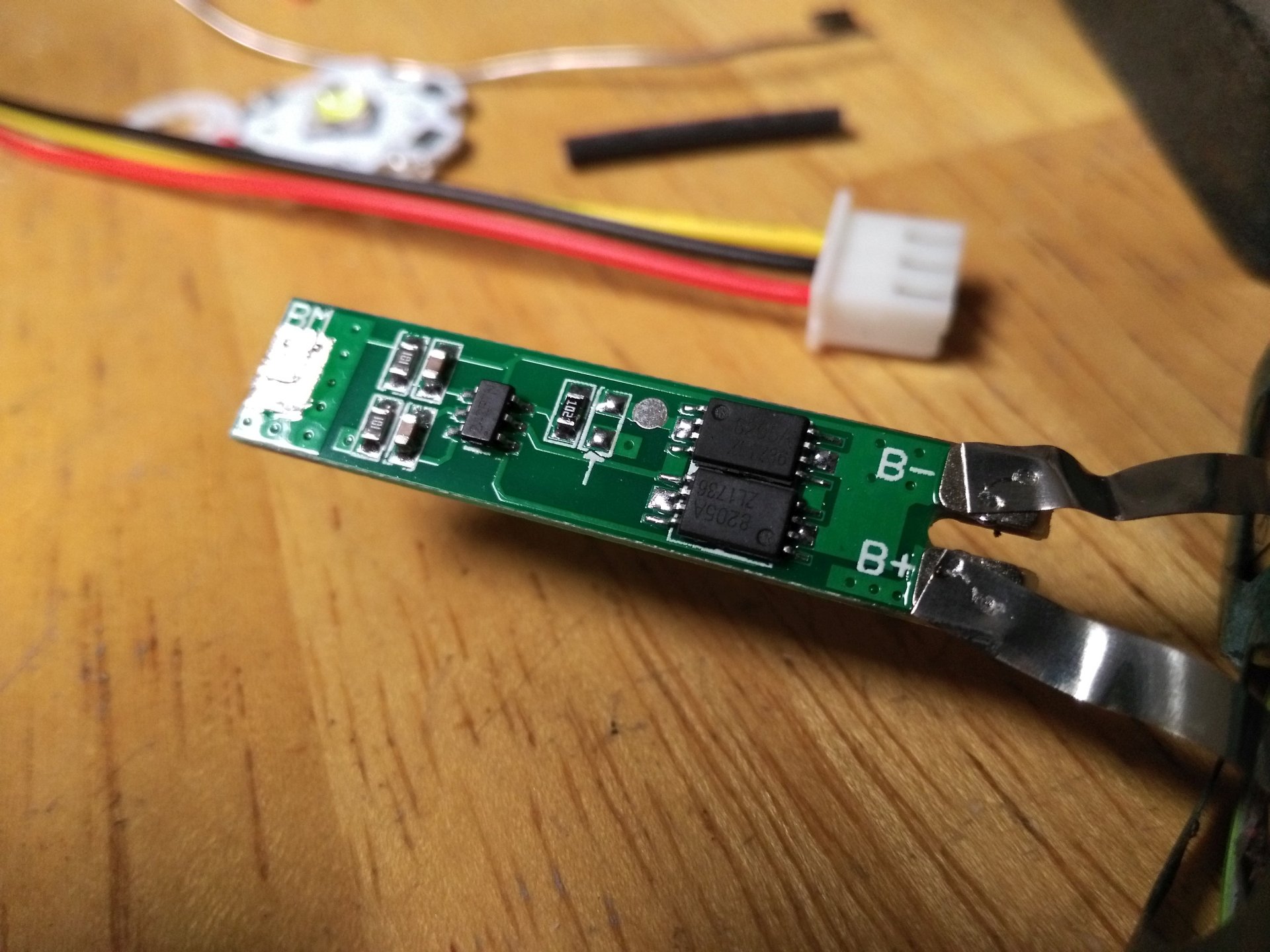
I then soldered a balance lead in place in order to monitor the cells, balance charged the cells on my hobby charger, and performed additional discharge tests. Cells measured 4.203v & 4.196 with a DMM after balance charging.

I then performed a 2.0A discharge test with the balance lead to monitor the individual cells. The test yielded 2,483mAh (down from 2,511mAh on the initial unbalanced pack). Looking at the logs of the cell voltages, they were only 0.07v out of balance by the end (much better than the 4-cell pack). Immediately at the end of the discharge test the cells were at 3.32v and 3.39v. I’m unsure why the Hobby Charger quite before they reached 3.00v. After a recharge of the pack (regular charge, not balance charge) the cells measured 4.171v and 4.180v. I ran another 2A discharge test monitoring over the balance lead and the pack did discharge one of the cells to 2.993v with the other at 3.225v yielding 2,494mAh.
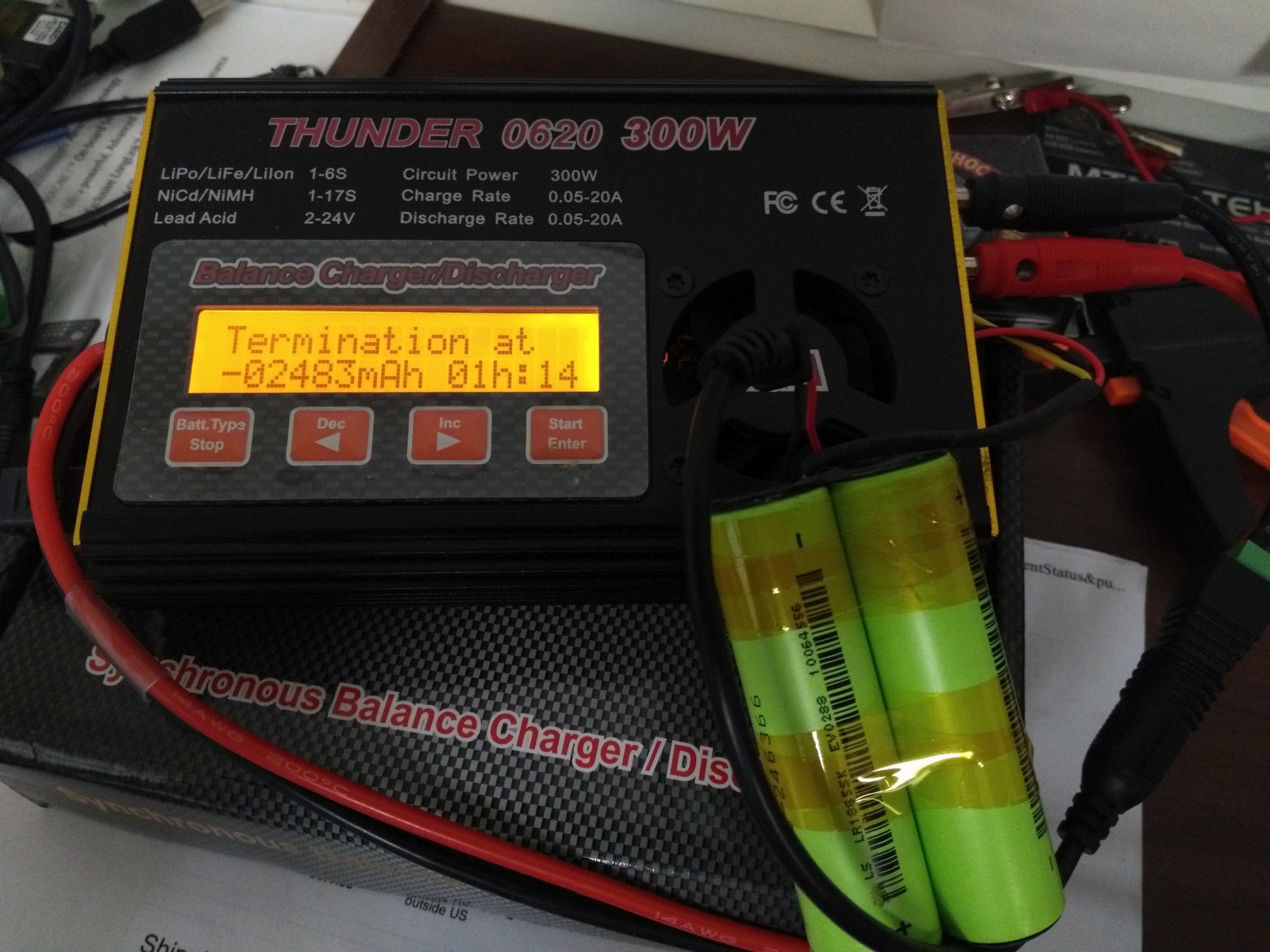
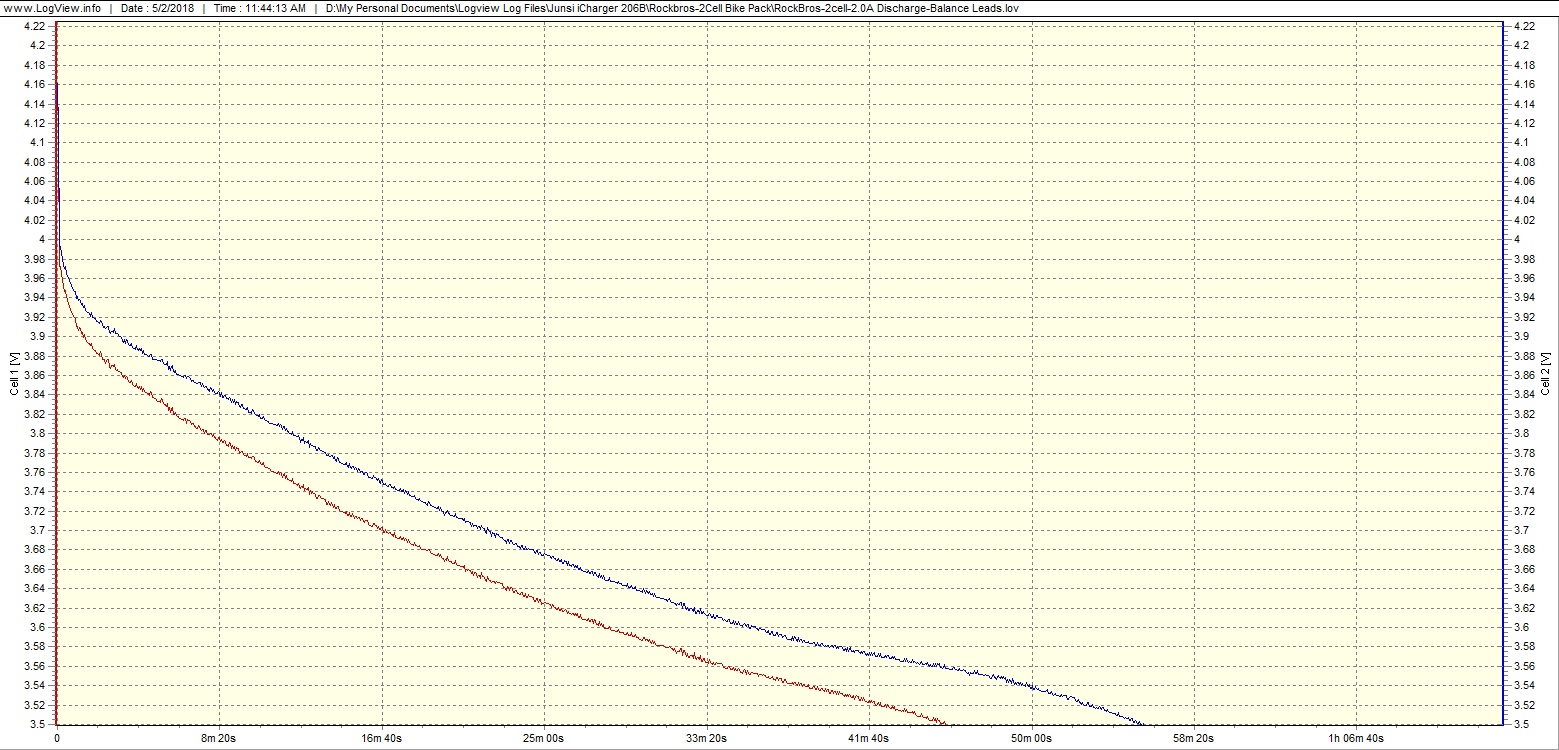
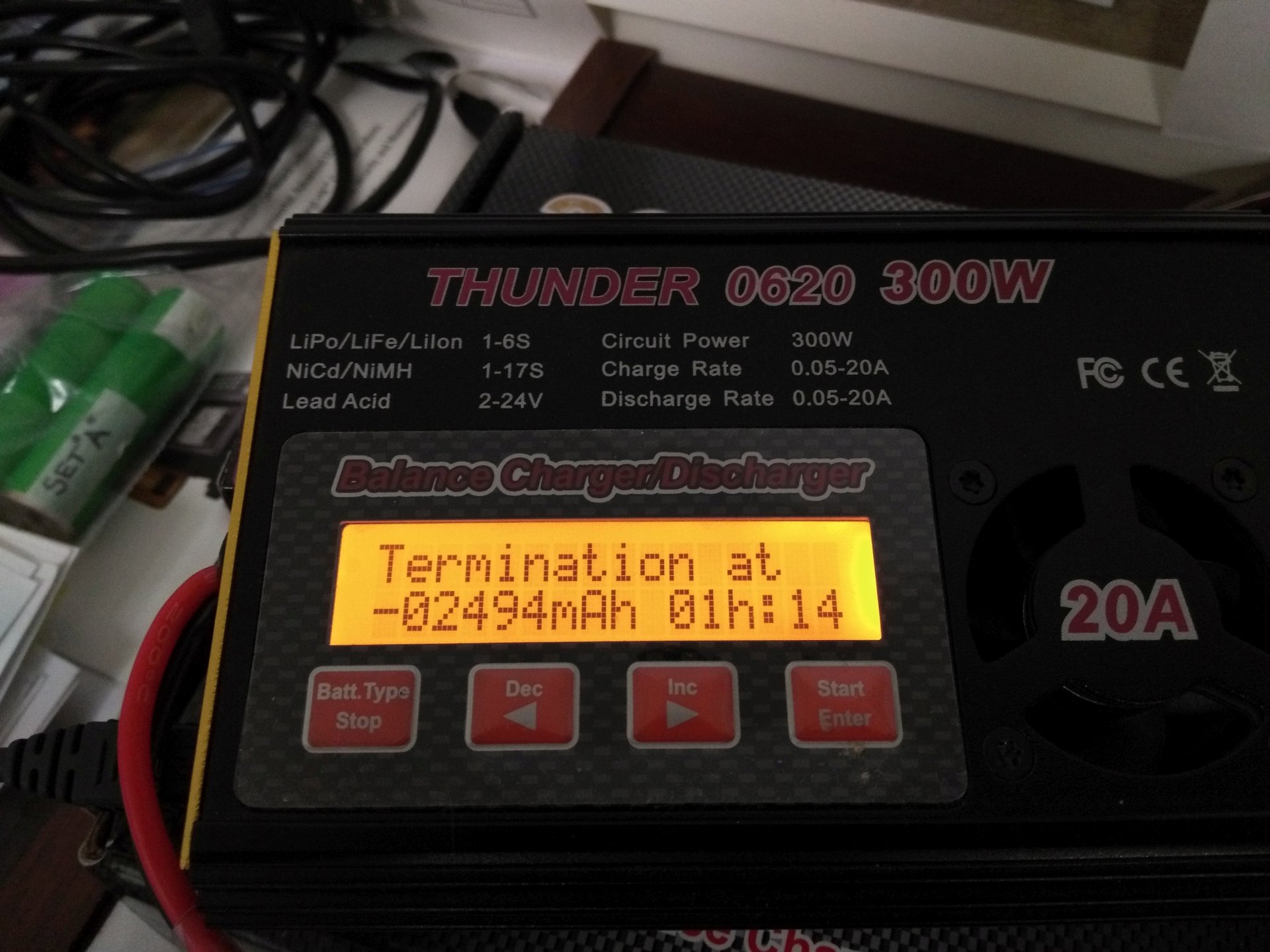
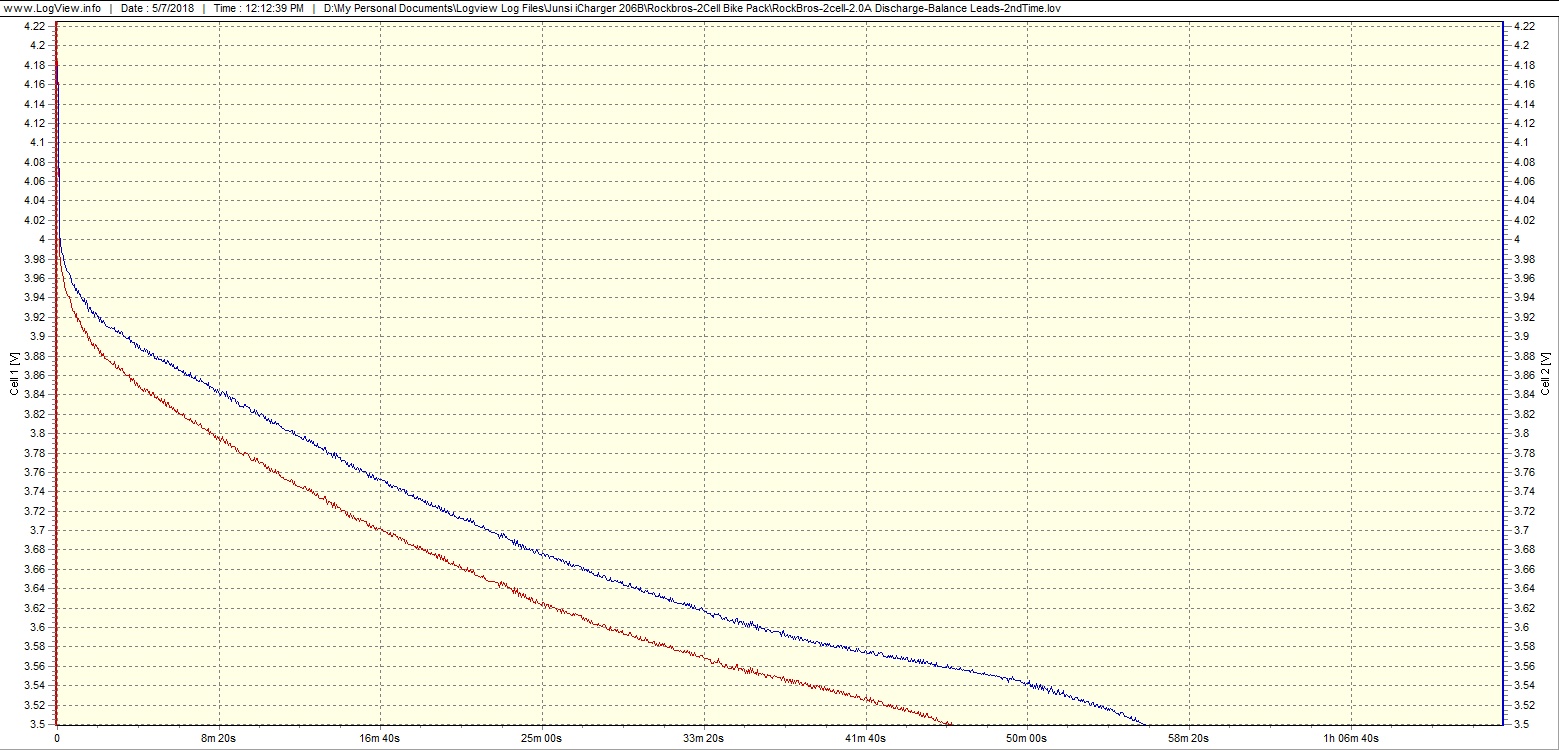
I then logged a standard charge at 1A on the hobby charger. The cells measured 3.40v and 3.497 at start and then measured 4.201v and 4.193v at the end.
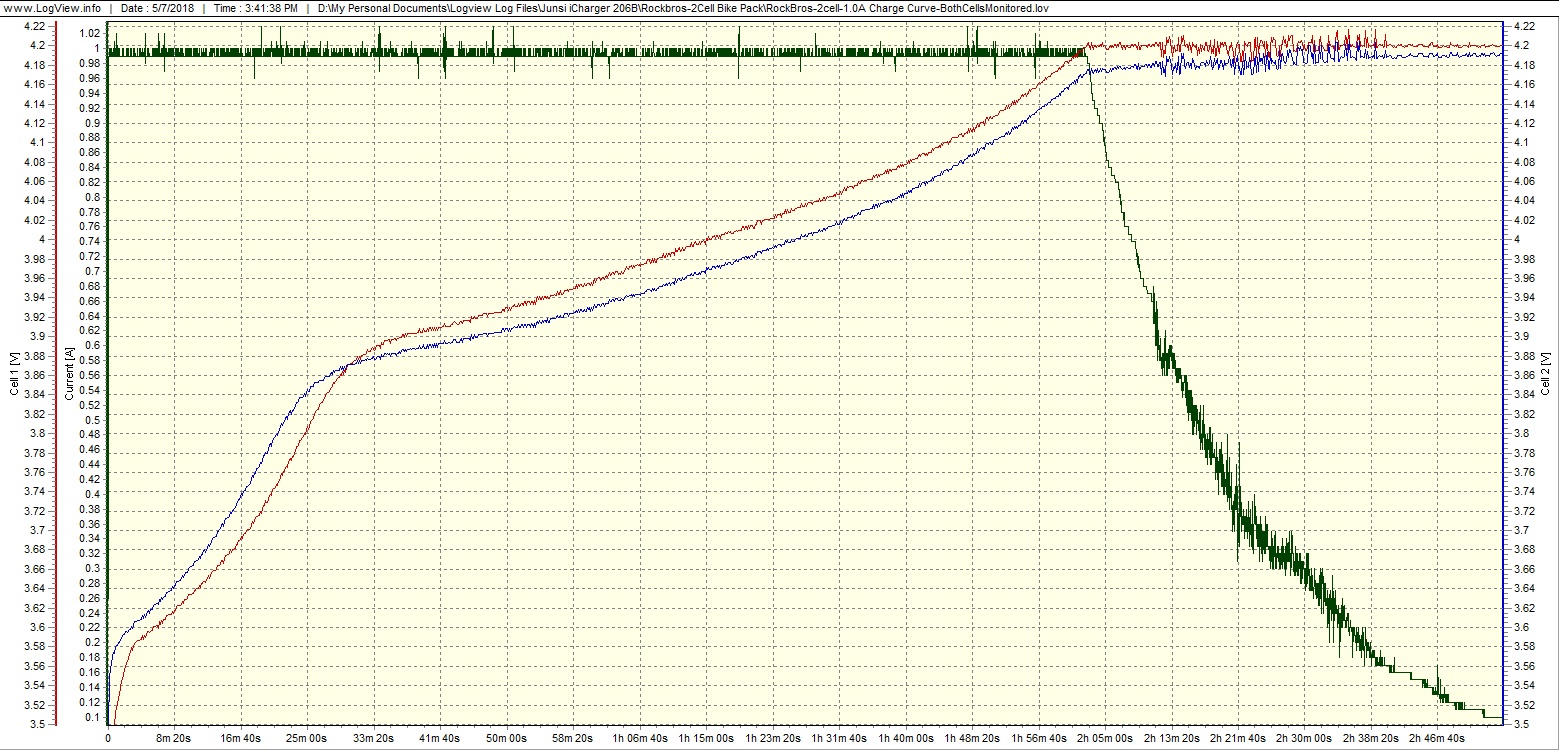
It is hard to gauge a packs long-term performance on just a few cycles, but I’m going to say that these cells will remain close enough in balance to not have a significant decrease in performance for quite a few cycles (i.e. a few years use by an average user).
All in all I’ll give this pack a very acceptable 3.5 out of 5 stars (same as I gave the 4-cell pack). The only real negative I found is that the pairs were assembled out of balance and most users will not open it up to balance them. I don’t believe this is a big issue since capacity testing showed little increase after balancing and the protection circuit is there to protect the pack from any serious interactions of out of balance cells. The exposed wiring on the power lead is also a negative, but that could vary greatly from pack to pack. I wouldn’t hesitate to use this pack myself or recommend it to others.
I again thank FastTech for providing this pack for review and hope you enjoyed it!
EDIT 6\8\2018: Comparison Discharge Graphs at 2.0A Discharge Rate:
This 2-cell pack is red in each of the graphs below.
Here is a graph comparing the RockBros 2-cell to the RockBros 4-cell:
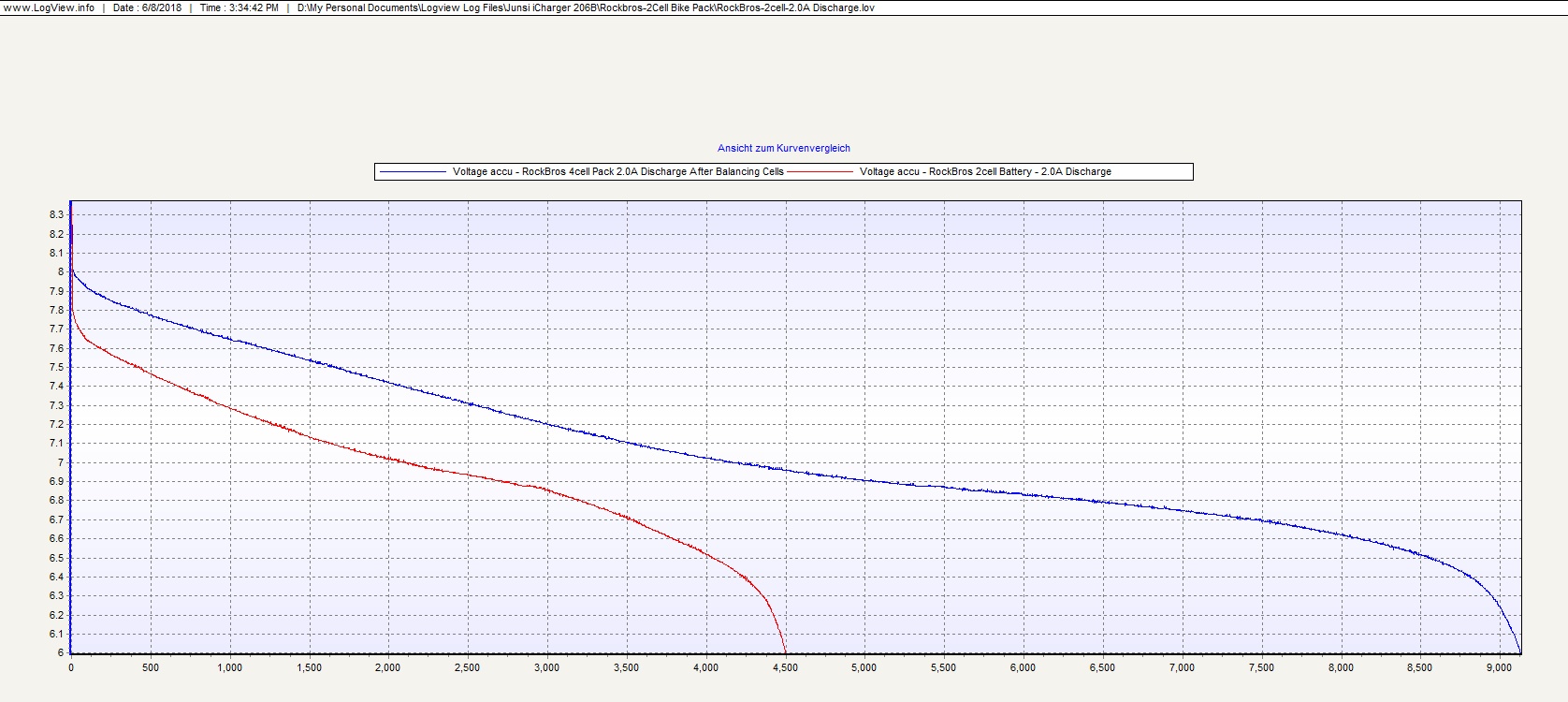
Here is a comparison between the 2-cell RockBros and my modded 2-cell Fenix case with a pair of Unprotected Sony US18650GR (G8) 2,600mAh cells (and the RockBros won out):
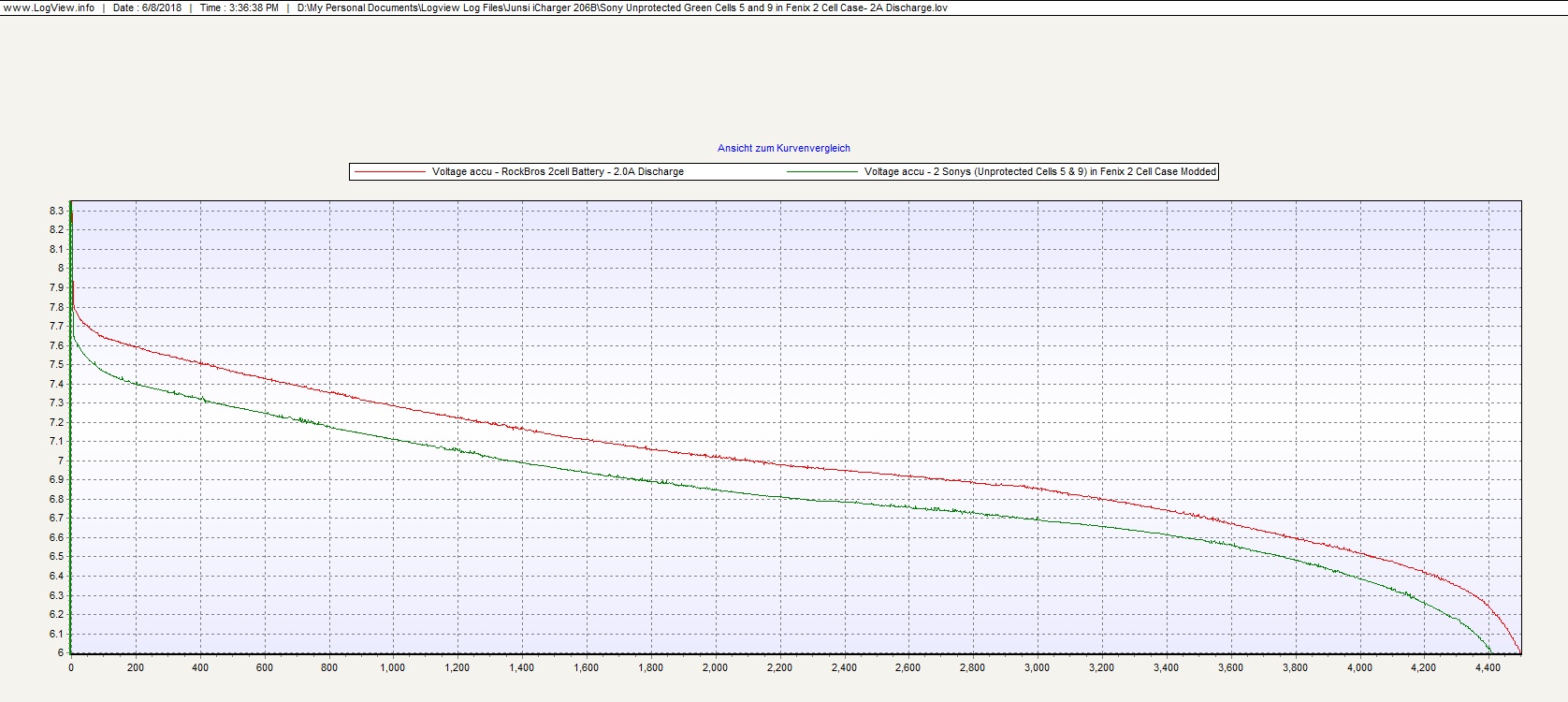
Comparison to a junky low capacity 2S2P Chinese pack included with HD-016 (the 2-cell holds its voltage pretty well in comparison to parallel cell pairs!):
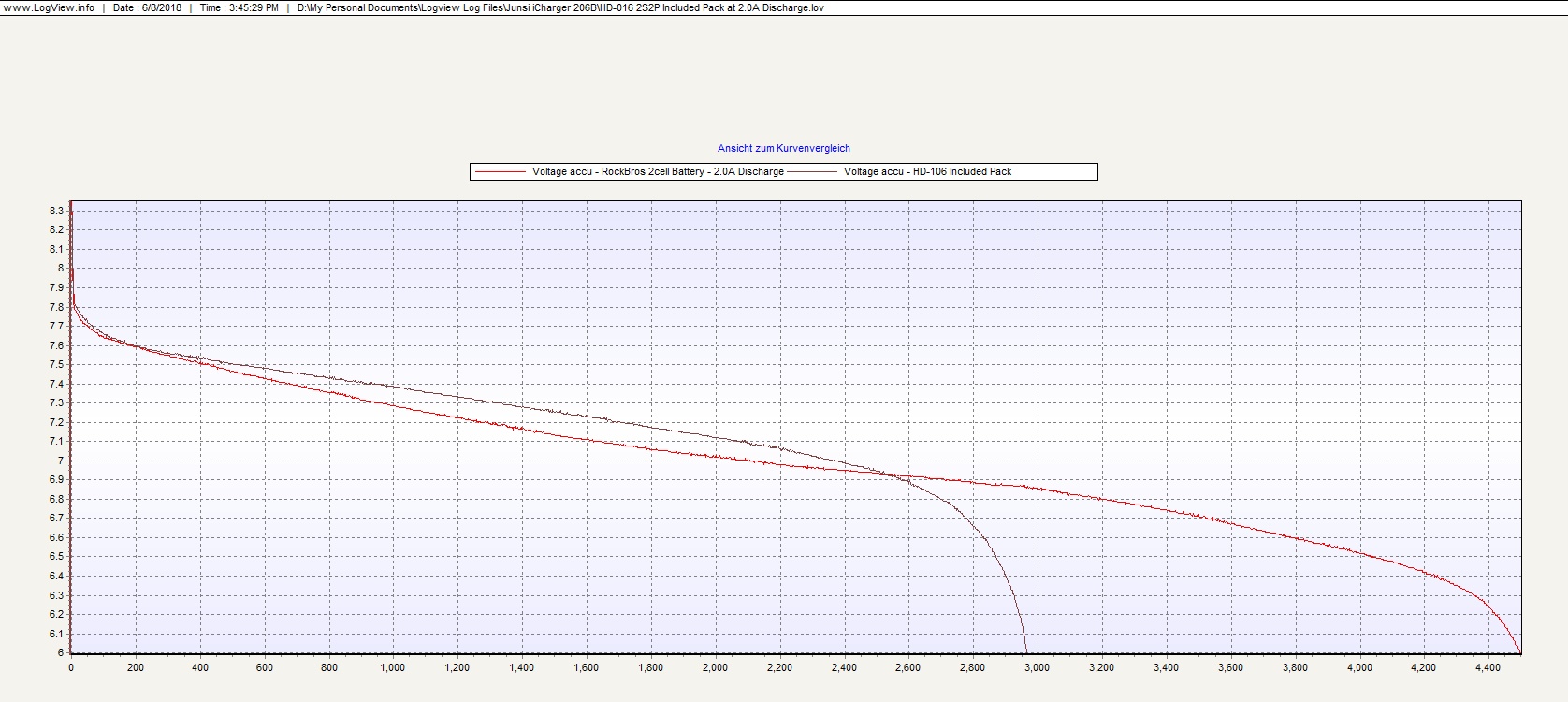
Lastly, and hardly fair, is a comparison to Ledoman's Panasonic NCR18650B 2S2P Pack:
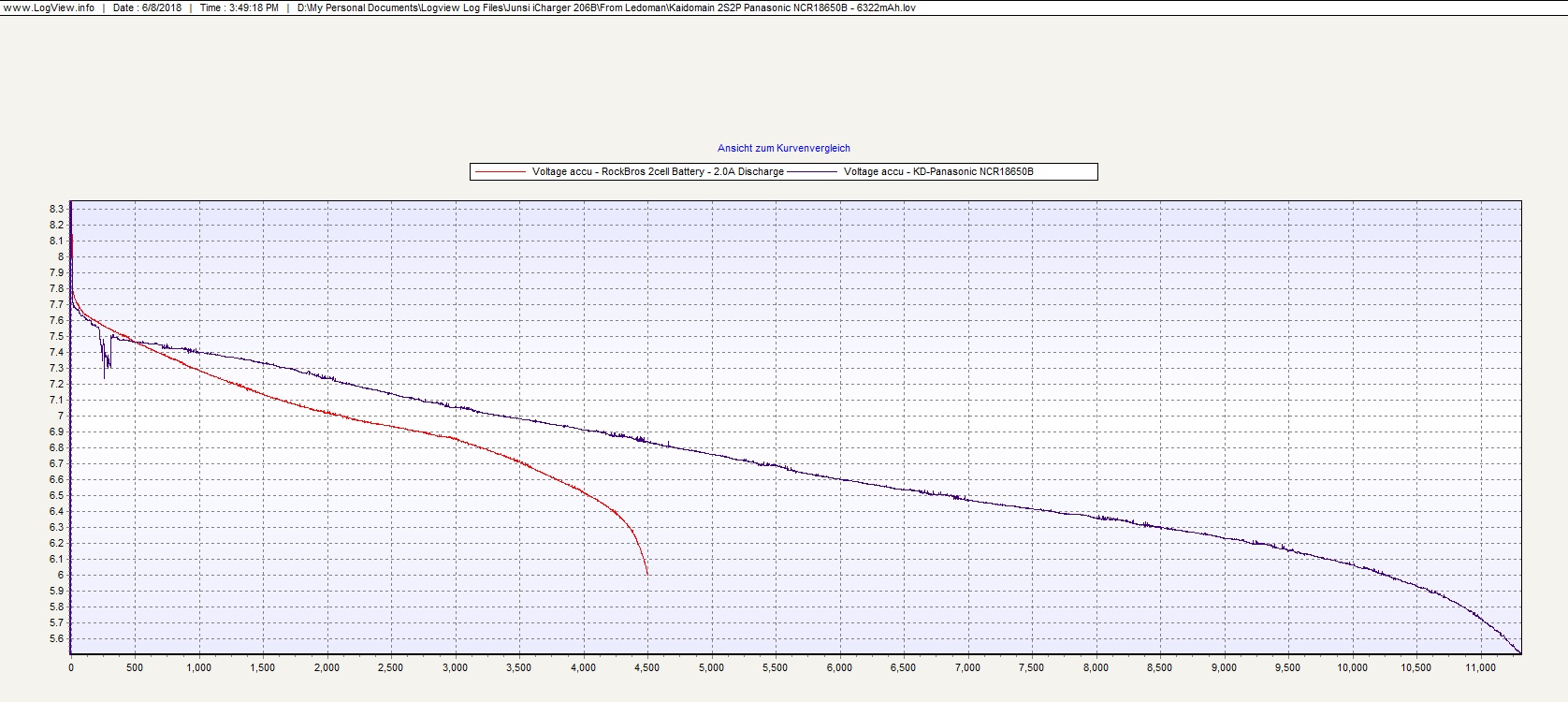
Perhaps Ledoman will send me his test on the Panasonic 2-cell pack for a more fair comparison :) .
Ask and ye shall receive! Comparison to Ledoman's Kaidomain 2-cell Panasonic NCR18650GA pack (he discharged down to 5.00v, I discharged to 6.00v)
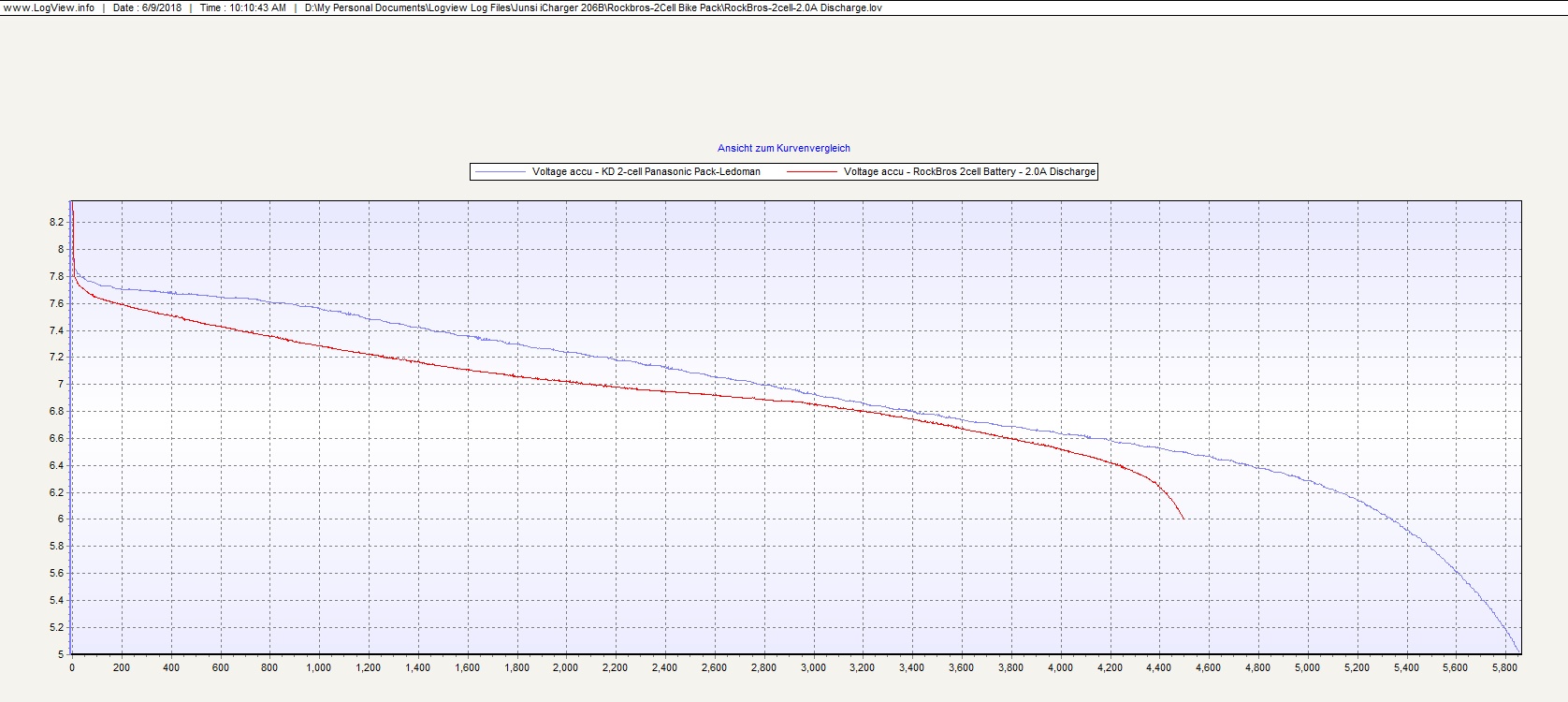
-Garry
This Review is also posted over at the MTBR Lights and Night Riding forum.